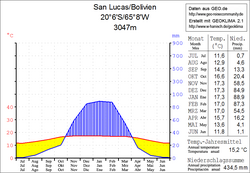Corma
| Corma | ||
|---|---|---|
| Basic data | ||
| Residents (state) | 204 pop. (2012 census) | |
| height | 3226 m | |
| Post Code | 01-0702-0800-8001 | |
| Telephone code | (+591) | |
| Coordinates | 20 ° 14 ′ S , 65 ° 3 ′ W | |
|
|
||
| politics | ||
| Department | Chuquisaca | |
| province | Nor Cinti Province | |
| climate | ||
 Climate diagram San Lucas |
||
Corma is a town in the Chuquisaca department in the South American Andean state of Bolivia .
location
Corma is the eleventh largest town in the canton of Ocurí in the municipality of San Lucas in the province of Nor Cinti . The village is located at an altitude of 3226 m on the Río Corma , which becomes the Río Malliri downstream .
geography
Corma is located on the southwestern foothills of the Bolivian Cordillera Central , between the Altiplano in the west and the Bolivian lowlands in the east. The climate is a cool, moderate mountain climate with a typical time of day climate , in which the mean temperature differences fluctuate more strongly during the day than during the year.
The annual average temperature in the district is around 15 ° C (see climate diagram San Lucas), the monthly averages fluctuate between almost 12 ° C in June / July and 17 ° C from November to March. The annual precipitation is 430 mm and has seven arid months from April to October with monthly values below 20 mm, notable monthly precipitation only falls from December to February with values of 80 to 90 mm each.
Transport network
Corma is 311 kilometers by road south of Sucre , the capital of the department.
The 898-kilometer Ruta 5 highway runs through Sucre and leads from the Cordillera Oriental across the Altiplano to the Chilean border. From Sucre, the road leads 169 kilometers in a south-westerly direction to Potosí , where it meets the north-south running Ruta 1 . From there it is another 122 kilometers on Ruta 1 to Padcoyo . From there, an unpaved road leads eastwards via Ocurí to Palacio Tambo . In Ocurí, a country road branches off in a southerly direction and continues via Corma and Khollpa Khasa to Malliri and Chiñimayu .
population
The population of the village has decreased slightly over the past decade:
| year | Residents | source |
|---|---|---|
| 1992 | no detailed data | census |
| 2001 | 222 | census |
| 2012 | 204 | census |
Due to the historical population distribution, the region has a high proportion of Quechua population, in the municipality of San Lucas 98.6 percent of the population speak the Quechua language.
Individual evidence
- ↑ Instituto Nacional de Estadística Bolivia (INE) 1992 ( Memento of the original from April 23, 2014 in the Internet Archive ) Info: The archive link has been inserted automatically and has not yet been checked. Please check the original and archive link according to the instructions and then remove this notice.
- ↑ INE - Instituto Nacional de Estadística Bolivia 2001 ( Memento of the original from December 22, 2014 in the Internet Archive ) Info: The archive link was automatically inserted and not yet checked. Please check the original and archive link according to the instructions and then remove this notice.
- ↑ INE - Instituto Nacional de Estadística Bolivia 2012 ( Memento of the original from July 22, 2011 in the Internet Archive ) Info: The archive link has been inserted automatically and has not yet been checked. Please check the original and archive link according to the instructions and then remove this notice.
- ↑ INE social data Chuquisaca 2001 ( Memento of the original from October 29, 2013 in the Internet Archive ) Info: The archive link was inserted automatically and has not yet been checked. Please check the original and archive link according to the instructions and then remove this notice. (PDF; 4.4 MB)
Web links
- Relief map 6533-II of the Estancia Padcoyo region 1: 50,000 (PDF; 1.82 MB)
- Relief map of the Camargo region 1: 250,000 (PDF; 10.6 MB)
- Municipio San Lucas - General Maps No. 10702
- Municipio San Lucas - detailed map and population data (PDF; 986 kB) ( Spanish )
- Departamento Chuquisaca - social data of the municipalities (PDF; 4.21 MB) ( Spanish )
